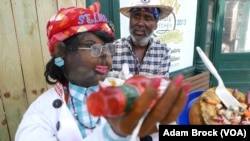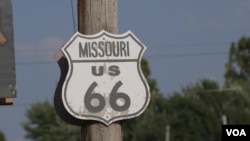St. Louis, the Gateway City, is the largest city in Missouri. Today, it felt like the hottest, too. Rising above the city’s tallest buildings, and overlooking the Mississippi River, is the 192-meter-tall Gateway Arch. Built by Eero Saarinen 50 years ago, the Arch honors the Americans who settled the western United States.
Park Ranger Karen Steuber spoke to us about that period of history. She said hundreds of thousands of Americans began moving west after President Thomas Jefferson completed the Louisiana Purchase. The trip was long, difficult and dangerous. St. Louis was the last city where the travelers could stock up on food and other provisions.
The shiny Gateway Arch is beautiful from the outside. But it also provides great views to the city below. Visitors ride an elevator up and along the curve of the structure to get to the top and enjoy the scenes below.
St. Louis has some colorful characters, like folk artist Jamaica Ray. He was born in St. Louis but moved to the Caribbean nation of Jamaica when he was eight. Now, Jamaica Ray is back in the city of his birth making expressive cloth and plastic sculptures of people real and imagined.
From even a short distance a viewer can be easily tricked into thinking a Jamaica Ray sculpture is actually a real person. “I will tell you many people have said that to me,” the artist said.
Jamaica Ray also makes beautiful painted steel drums. And he plays them – quite well. He entertains people outside of Crown’s Candy Kitchen, an old soda fountain restaurant. On weekends, the wait for the charming little shop with delicious food can be 60 to 90 minutes.
Once we left St. Louis, we found that Route 66 can be tricky to navigate. The road runs along Interstate 44 for a long period. But the Mother Road also changes sides of Interstate 44 often, sometimes without much warning. We also came to more than a few dead ends.
We stopped in Cuba, Missouri, for some postcards and “Route” beers. The bottle showed a Route 66 sign. Of course, the name of the soda is a play on words: root and route. Root beer is normally made with the root of the sassafras plant. Route means road or way. But, regardless of spelling, the cold, sweet drink was a refreshing break.
Route 66 also got a little hillier during today’s section, as we drove toward the Ozark Mountains. The landscapes were green and treed and dotted with cows.
We next stopped in the town of Lebanon, Missouri, whose residents “bowled us over” with their friendliness. We actually went to a bowling alley right on Route 66! Starlite Lanes opened in the 1950s. It is right across the street from Munger Moss Motel, where Route 66 travelers have been staying since the 1946.
At the Starlite Lanes bowling alley, we talked with a few locals who have clear memories of the Mother Road in its heyday. Jeannie Tait grew up in Lebanon. She is known around town as an excellent bowler.
She said Route 66 created business and brought travelers to her small town. She expressed sadness about the destruction of some local landmarks along the Mother Road. An historic bridge just outside of town, for example, has been closed for some time. The city doesn’t have the money to repair it. So, instead, it may be torn down, and replaced with a more modern bridge. Jeannie said she wishes the town could better preserve what it has.
“Modern isn’t always better,” Jeannie said.
You may have noticed the interesting town names we mentioned – Cuba and Lebanon! Does your country have towns named after other places in the world? Let us know!
_______________________________________________________________
Words in This Story
provisions - n. a supply of food and other things that are needed
navigate - v. to find the way to get to a place when you are traveling in a ship, airplane, or car.
dead end - n. an end of a road or passage from which no exit is possible
bowl over - idiom. to surprise or overwhelm someone.
heyday - n. the time when someone or something is most successful or popular








